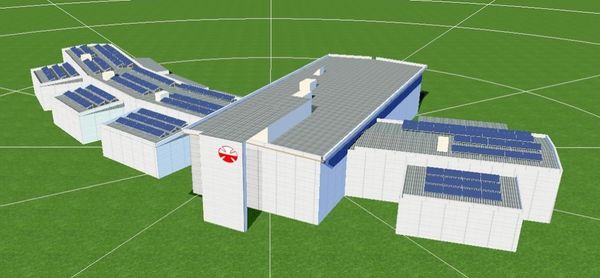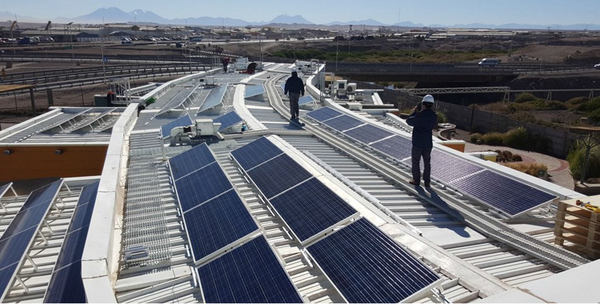Knowledge fuels change
For over a decade, Energypedia has shared free, reliable energy expertise with the world.
We’re now facing a serious funding gap.
Help keep this platform alive — your donation, big or small, truly matters!
Thank you for your support
Difference between revisions of "Public Solar Roofs Program in Chile"
***** (***** | *****) m (→Objectives) |
***** (***** | *****) |
||
| (11 intermediate revisions by 3 users not shown) | |||
| Line 1: | Line 1: | ||
| − | = Overview = | + | = <span style="color:#008000;">Overview</span> = |
| − | The Ministry of Energy from Chile is currently implementing the Public Solar Roofs Program (PTSP, from its Spanish acronym), which involves the installation of photovoltaic solar systems on roofs of public buildings. The main objective of PTSP is to contribute to the maturation of the photovoltaic market for self-consumption. PTSP will operate for the following three years and has a budget of 13 million US dollars. The [http://www.giz.de/en/worldwide/23041.html Deutsche Gesellschaft für internationale Zusammenarbeit] (GIZ) has been supporting in the planning, implementation and dissemination of PTSP as part of | + | The Ministry of Energy from Chile is currently implementing the Public Solar Roofs Program (PTSP, from its Spanish acronym), which involves the installation of photovoltaic solar systems on roofs of public buildings. The main objective of PTSP is to contribute to the maturation of the photovoltaic market for self-consumption. PTSP will operate for the following three years and has a budget of 13 million US dollars. The [http://www.giz.de/en/worldwide/23041.html Deutsche Gesellschaft für internationale Zusammenarbeit]<span style="font-size: 13.6000003814697px; line-height: 20.4000015258789px; background-color: rgb(255, 255, 255);"> (GIZ)</span> has been supporting in the planning, implementation and dissemination of PTSP as part of a project financed by the International Climate Initiative (IKI), through the Ministry of Environment of Germany. |
| + | <br/> | ||
| − | = Objectives = | + | = <span style="color:#008000;">Objectives</span> = |
The specific objectives of PTSP are: | The specific objectives of PTSP are: | ||
| − | *Stimulate the photovoltaic market through demand of | + | *Stimulate the photovoltaic market through demand of PV systems from the state, which will be installed in public buildings. |
*Provide information for free public access on costs and conditions of PV projects for self-consumption in Chile. | *Provide information for free public access on costs and conditions of PV projects for self-consumption in Chile. | ||
*Evaluate the current rules and procedures for self-consumption PV systems, according to Distributed Generation Law. | *Evaluate the current rules and procedures for self-consumption PV systems, according to Distributed Generation Law. | ||
*Contribute to the reduction of electricity costs in public buildings. | *Contribute to the reduction of electricity costs in public buildings. | ||
| + | |||
| + | <br/> | ||
The implementation of PTSP has recently started with one public tender, already awarded, for the installation of PV systems in three buildings in the city of Calama. The size of these installations ranges between 5 – 40 kWp. | The implementation of PTSP has recently started with one public tender, already awarded, for the installation of PV systems in three buildings in the city of Calama. The size of these installations ranges between 5 – 40 kWp. | ||
| − | + | [[File:Instituto Teletón of Calama.jpg|thumb|left|600px|Public Solar Roofs Program in Chile Teletón in Calama in PV Sol|alt=Instituto Teletón of Calama]]<br/><div style="clear: both"></div> | |
| − | [[File:Instituto Teletón of Calama.jpg|thumb|left|600px| | ||
| − | |||
Currently, there are five other tender processes undergoing for the following public buildings: Instituto Teletón of Santiago (70 kWp), Centro Cultural Gabriela Mistral, GAM (100 kWp), four projects at Copiapó (92 kWp) and seven projects at Parral I and II (185 kWp). Additional to these projects, approximately other ten tender processes will be launched during 2015. | Currently, there are five other tender processes undergoing for the following public buildings: Instituto Teletón of Santiago (70 kWp), Centro Cultural Gabriela Mistral, GAM (100 kWp), four projects at Copiapó (92 kWp) and seven projects at Parral I and II (185 kWp). Additional to these projects, approximately other ten tender processes will be launched during 2015. | ||
| Line 24: | Line 25: | ||
More information can be found at [http://www.minenergia.cl/techossolares minenergia.cl/techossolares]. All public tenders will be published on [http://www.mercadopublico.cl/ mercadopublico.cl]. | More information can be found at [http://www.minenergia.cl/techossolares minenergia.cl/techossolares]. All public tenders will be published on [http://www.mercadopublico.cl/ mercadopublico.cl]. | ||
| + | <br/> | ||
| − | = | + | [[:File:Factsheet ley20571IKI aleman.pdf|Staatliches Solardachprogramm des chilenischen Energieministeriums öffnet Ausschreibungen auch für internationale Firmen, 2015]]<span style="line-height: 20.4px; font-size: 13.6px;"></span><span style="line-height: 20.4px; font-size: 13.6px;"> (German) </span><br/> |
| + | <div>[[File:Public Solar Roofs Program in Chile Teletón in Calama (40 kWp).png|thumb|left|600px|Public Solar Roofs Program in Chile Teletón in Calama (40 kWp)|link=File:Public Solar Roofs Program in Chile Teletón in Calama (40 kWp).png]]<br/><span style="line-height: 20.4px; font-size: 13.6px;"></span></div><div> | ||
| + | = <span style="color: rgb(0, 128, 0);">Training</span> = | ||
| − | + | == <span style="background-color: initial; font-size: 21.76px;"><span style="color: rgb(0, 128, 0);">Guides for building-owners and PV-Installation Companies</span> </span><br/> == | |
| − | + | </div> | |
| + | | ||
| + | |||
| + | As a part of the Support to the Ministry of Energy in the Public Solar Roofs Programme, capacitation in terms of operation and maintenance was given to 45 users of photovoltaic installations established during the execution of the "PTSP Programme" . | ||
| + | |||
| + | During the capacitation two guides were provided which are detailed below. | ||
| + | |||
| + | | ||
| + | |||
| + | '''PV BUILDING EVALUATION GUIDE.''' | ||
| + | |||
| + | Delivers the requirements for buildings to install a PV system, within the guide can be found how to select a stock building that requires a feasibility study and how to discard the ones that don’t, leading to an improvement in efficiency in searching for buildings with a PV installation potential. | ||
| + | |||
| + | | ||
| + | |||
| + | '''OPERATION AND MAINTENANCE FOR PV SYSTEMS.''' | ||
| + | |||
| + | This guide takes in to consideration critical aspects of operation and maintenance, the guide delivers a tool that enables users to diagnose and evaluate the operation parameters from a PV inspection plan, allowing failure identification and troubleshooting in addition preventive maintained measures and the frequency of execution is explained. | ||
| + | |||
| + | <span style="font-family: Arial, sans-serif; font-size: 13.3333px; background-color: rgb(255, 255, 255);"> </span> | ||
= References = | = References = | ||
| + | *[http://www.minenergia.cl/techossolares/ minenergia.cl/techossolares/] | ||
| + | |||
| + | [[Category:Photovoltaic_(PV)]] | ||
| + | [[Category:Chile]] | ||
[[Category:Solar]] | [[Category:Solar]] | ||
| − | |||
| − | |||
Latest revision as of 17:37, 18 October 2016
Overview
The Ministry of Energy from Chile is currently implementing the Public Solar Roofs Program (PTSP, from its Spanish acronym), which involves the installation of photovoltaic solar systems on roofs of public buildings. The main objective of PTSP is to contribute to the maturation of the photovoltaic market for self-consumption. PTSP will operate for the following three years and has a budget of 13 million US dollars. The Deutsche Gesellschaft für internationale Zusammenarbeit (GIZ) has been supporting in the planning, implementation and dissemination of PTSP as part of a project financed by the International Climate Initiative (IKI), through the Ministry of Environment of Germany.
Objectives
The specific objectives of PTSP are:
- Stimulate the photovoltaic market through demand of PV systems from the state, which will be installed in public buildings.
- Provide information for free public access on costs and conditions of PV projects for self-consumption in Chile.
- Evaluate the current rules and procedures for self-consumption PV systems, according to Distributed Generation Law.
- Contribute to the reduction of electricity costs in public buildings.
The implementation of PTSP has recently started with one public tender, already awarded, for the installation of PV systems in three buildings in the city of Calama. The size of these installations ranges between 5 – 40 kWp.
Currently, there are five other tender processes undergoing for the following public buildings: Instituto Teletón of Santiago (70 kWp), Centro Cultural Gabriela Mistral, GAM (100 kWp), four projects at Copiapó (92 kWp) and seven projects at Parral I and II (185 kWp). Additional to these projects, approximately other ten tender processes will be launched during 2015.
It is important to mention that tender processes for the PTSP will continue for the next two years, including several Chilean cities. Also, the tender process allows the participation of international companies with robust experience.
More information can be found at minenergia.cl/techossolares. All public tenders will be published on mercadopublico.cl.
Training
Guides for building-owners and PV-Installation Companies
As a part of the Support to the Ministry of Energy in the Public Solar Roofs Programme, capacitation in terms of operation and maintenance was given to 45 users of photovoltaic installations established during the execution of the "PTSP Programme" .
During the capacitation two guides were provided which are detailed below.
PV BUILDING EVALUATION GUIDE.
Delivers the requirements for buildings to install a PV system, within the guide can be found how to select a stock building that requires a feasibility study and how to discard the ones that don’t, leading to an improvement in efficiency in searching for buildings with a PV installation potential.
OPERATION AND MAINTENANCE FOR PV SYSTEMS.
This guide takes in to consideration critical aspects of operation and maintenance, the guide delivers a tool that enables users to diagnose and evaluate the operation parameters from a PV inspection plan, allowing failure identification and troubleshooting in addition preventive maintained measures and the frequency of execution is explained.





















